
Imagine you’re writer-director Jaime Robledo, and your play Watson won you just about every award in the book, including a pair of Scenies. Then imagine you’re writer-performer Vanessa Claire Stewart, whose Louis And Keely Live At The Sahara and its holiday spin-off won you just about every award in the book, including a grand total of four Scenies. Now try to think of what to do for an encore.
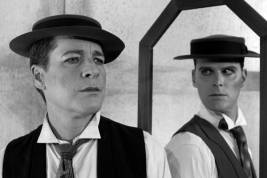 The answer to this conundrum turns out to be for Robledo and Stewart to join forces in the creation of a show that not only showcases their prodigious talents and those of Stewart’s inimitable husband French (of 3rd Rock fame) but pays tribute to the genius that was silent screen legend Buster Keaton.
The answer to this conundrum turns out to be for Robledo and Stewart to join forces in the creation of a show that not only showcases their prodigious talents and those of Stewart’s inimitable husband French (of 3rd Rock fame) but pays tribute to the genius that was silent screen legend Buster Keaton.
The result of this three-part collaboration is Stoneface: The Rise And Fall And Rise of Buster Keaton, written by Vanessa, directed by Jaime, and starring French in the title role. A surreal, time-traveling bio-dramedy, Stoneface not only gives Keaton (Entertainment Weekly’s 7th-greatest director of all time and AFI’s 21st-greatest male star of all time) his due, it does so in the most inspired and entertaining of ways.
The biographical details of Buster’s life are all there, though not necessarily in chronological order.
We watch a silent movie recreation of Keaton’s early days in vaudeville, where a childhood fall earned him the nickname Buster for taking a “buster” of a spill and coming up smiling, upon which, discovering that he got fewer laughs when laughing at himself, Buster began adopting his trademark “Stoneface.”
We discover to our astonishment just how Buster learned how to work a movie camera. He simply took one apart, then figured out how to put it back together!
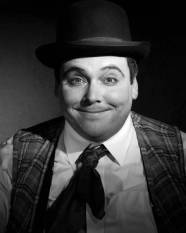 We meet Joseph Schenck (Jake Broder), who hired Buster to work for his film studio, and Roscoe “Fatty” Arbuckle (Scott Leggett), who like Buster went on to silent film stardom (though in Fatty’s case it was cut short by scandal).
We meet Joseph Schenck (Jake Broder), who hired Buster to work for his film studio, and Roscoe “Fatty” Arbuckle (Scott Leggett), who like Buster went on to silent film stardom (though in Fatty’s case it was cut short by scandal).
We see how studio and audience reaction to Buster’s Civil War epic The General pretty much ended its creator-star’s directorial career, though the movie is now considered Keaton’s chef-d’oeuvre.
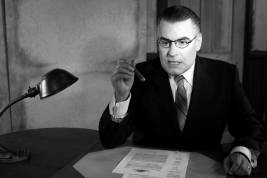 We witness Buster’s come-down from the superstar stratosphere, making two-reelers for the not-so-prestigious Educational Pictures, and later on, Buster’s battles with legendary studio head Louis B. Mayer (Pat Towne), who was not about to give one of his stable of stars any sort of creative freedom, let alone pick the projects he’d be working on.
We witness Buster’s come-down from the superstar stratosphere, making two-reelers for the not-so-prestigious Educational Pictures, and later on, Buster’s battles with legendary studio head Louis B. Mayer (Pat Towne), who was not about to give one of his stable of stars any sort of creative freedom, let alone pick the projects he’d be working on.
A white-haired Charlie Chaplin (Guy Picot) even makes his appearance in Stoneface just as the real Charlie did in Keaton’s life when Buster was at just about his down-and-outest.
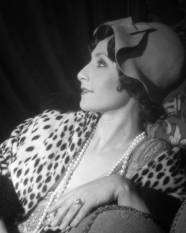 As for Keaton’s personal life, Stoneface gives us Buster’s marriage to Natalie Talmadge (Tegan Ashton Cohan), sister to film stars Norma and Constance, who following the couple’s divorce made damn sure that her ex would have no contact with his two sons, even going so far as to change their last name to hers.
As for Keaton’s personal life, Stoneface gives us Buster’s marriage to Natalie Talmadge (Tegan Ashton Cohan), sister to film stars Norma and Constance, who following the couple’s divorce made damn sure that her ex would have no contact with his two sons, even going so far as to change their last name to hers.
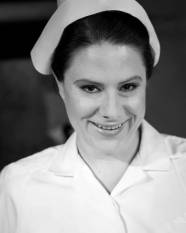 Stoneface doesn’t sugar-coat Buster’s battle with the bottle, though Robledo and the Stewarts do mine the comic possiblities of his marriage to his nurse Mae Scriven (Erin Parks), whom he wed during an alcoholic blackout. Still, it wasn’t until his marriage to wife number three, Eleanor Norris (Rena Strober, who doubles as Norma Talmadge) that the onetime superstar was able to begin salvaging his nearly defunct career.
Stoneface doesn’t sugar-coat Buster’s battle with the bottle, though Robledo and the Stewarts do mine the comic possiblities of his marriage to his nurse Mae Scriven (Erin Parks), whom he wed during an alcoholic blackout. Still, it wasn’t until his marriage to wife number three, Eleanor Norris (Rena Strober, who doubles as Norma Talmadge) that the onetime superstar was able to begin salvaging his nearly defunct career.
Robledo and the Frenches take a Felliniesque approach to Buster’s life, even going to far as to have not one but two Busters, one young and promising, the other older though not necessarily wiser, a fact made clear when young Buster (Joe Fria) gives his older self the best “Snap out of it!” slap since Cher landed one on Nicolas Cage in Moonstruck (and not a fake “stage slap” either).
About half of Stoneface’s scenes are silent and supertitled with silent movie-style title cards projected above the stage, a device also used to set scenes and to reveal biographical information about Buster.
Even scenes with spoken dialog are given a silent-movie air, an effect enhanced by the production’s running soundtrack, an atmospheric original score performed live on the upright piano by its composer, musical director Ryan Johnson.
Stoneface makes ample use of videos and projections (designed by Ben Rock and Anthony Backman), beginning with that black-and-white silent movie depicting an early Buster Keaton appearance in his family’s vaudeville act, followed by an inspired sequence which has Stoneface’s cast of characters stepping one-by-one behind a movie screen, only to have their black-and-white filmic selves appear onscreen in perfect sync—and in identical costumes.
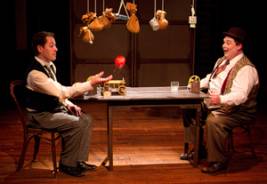 And speaking of inspired, in a scene based on one in Keaton’s classic film The Scarecrow, Buster and Fatty light each other’s cigars and pour each other drinks (among other assorted sight gags) using props they maneuver by pulling on cords attached to overhead pulleys.
And speaking of inspired, in a scene based on one in Keaton’s classic film The Scarecrow, Buster and Fatty light each other’s cigars and pour each other drinks (among other assorted sight gags) using props they maneuver by pulling on cords attached to overhead pulleys.
In its ballsiest sequence, Stoneface has the cojones to recreate live onstage one of Buster’s most famous stunts, one in which the façade of a two-ton, two-story building fell right down upon Buster, who escaped without a scratch, the comedian having stood precisely where an open window would pass right over him.
French Stewart is in a word superb, abandoning the quirky, madcap, slapstick persona that won him legions of fans during his six seasons as 3rd Rock’s Harry The Alien the better to vanish inside Buster Keaton’s deadpan exterior, his oh-so expressive eyes revealing a rainbow of emotions.
Fria is marvelous too in his own younger version of Buster, as is Leggett as Fatty, giving us both the brilliant comedian and the tragic victim of Hollywood’s morality police. Parks’ dryly humorous Mae, Cohan’s piquant Natalie, Strober’s warm Eleanor (in addition to her fine bit as movie star Norma), Broder’s dynamic Schenk, Conor Duffy’s tiptop dual turn as director Edward Sedgwick and comedian George Jessel, Towne’s imperious Louis B. Mayer, and Picot’s wise, generous Chaplin are all finely drawn characterizations.
Physically, the production owes much to its talented team of designers. Joel Daavid’s set recalls images we’ve seen of old silent movie lots, a design meticulously dressed by prop designer Heather Ho and exquisitely lit by Jeremy Pivnick in nostalgic, amber hues. Jessica Olson’s costumes are like a history lesson in silent movie-era attire. The terrific design package is completed by sound designer Robledo, dance choreographer Natasha Norman, stunt/fight choreographer Andrew Amani, fight captain Mike Mahaffey, special effects designer/master builder James McCartney, and makeup designer Amanda Rodil, alongside another dozen and a half crew members.
Working behind the scenes are producer Brian W. Wallis, associate producers French and Vanessa Stewart, consulting producer Brandon Clark, assistant director Jonas Oppenheim, stage manager Heatherlynn Gonzalez, and assistant stage manager Suze Campagna.
Though a significant number of Los Angeles World Premieres seem to vanish in the mists of memory once the final curtain has fallen, my guess is that Stoneface will have a considerable life post-Sacred Fools. Still, it’s hard to imagine it being nearly as perfectly staged without Robledo and the Stewarts encoring their work. This may be one regional theater production that will have to come as a package deal.
Sacred Fools Theater, 660 N. Heliotrope Dr., Hollywood.
www.sacredfools.org
–Steven Stanley
June 3, 2102
Photos: Shaela Cook


 Since 2007, Steven Stanley's StageSceneLA.com has spotlighted the best in Southern California theater via reviews, interviews, and its annual StageSceneLA Scenies.
Since 2007, Steven Stanley's StageSceneLA.com has spotlighted the best in Southern California theater via reviews, interviews, and its annual StageSceneLA Scenies.







 COPYRIGHT 2024 STEVEN STANLEY :: DESIGN BY
COPYRIGHT 2024 STEVEN STANLEY :: DESIGN BY